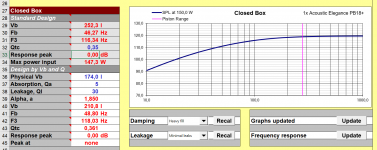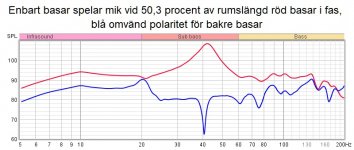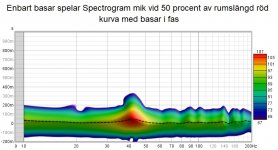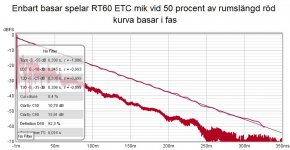Hi,
What is the ideal listening room dimension - same/same what is the best compromised listing room dimension.
Application will be horn loaded 300Hz up and 'whatever works best' below that.
Sincere question - I have to agree to or modify plans as presented.
Best to you,
Inrigo
What is the ideal listening room dimension - same/same what is the best compromised listing room dimension.
Application will be horn loaded 300Hz up and 'whatever works best' below that.
Sincere question - I have to agree to or modify plans as presented.
Best to you,
Inrigo
Speakers situated 2/3rds of the distance from listening position is a good starting point.
In other words, if the speakers are 10 feet apart, the ideal listening position is 15 feet away from them.
Of course, room acoustics and furniture placement are variables in this case.
In other words, if the speakers are 10 feet apart, the ideal listening position is 15 feet away from them.
Of course, room acoustics and furniture placement are variables in this case.
What is the ideal listening room dimension - same/same what is the best compromised listing
room dimension. Application will be horn loaded 300Hz up and 'whatever works best' below that.
Here's a good calculator. You'll notice that a high ceiling is very important, as is treatment.
Carpeted floors will help a lot.
amroc - THE Room Mode Calculator
Last edited:
If you want to follow the Golden Ratio, use 1 x 1.6 x 2.56 (Height, Width, Length). Ex. Height 3m, Width 3mx1.6=4.8m, Length 3mX2.56=7.68m
Or the more modern ratio 0.6 x 1 x 1.62, 3m x 5m x 8.1m suggested by Paul from PS Audio.
It is the choice of some of the audio designers like Paul from PS Audio, George Cardas from Cardas Auido....
Or the more modern ratio 0.6 x 1 x 1.62, 3m x 5m x 8.1m suggested by Paul from PS Audio.
It is the choice of some of the audio designers like Paul from PS Audio, George Cardas from Cardas Auido....
Last edited:
Hi,
Some interesting reading from serious source about room's dimension ratio:
Optimum dimension ratios for studios, control rooms and listening rooms - BBC R&D
I agree with Planet10, angled ceiling ( 30* or more, lowest part on loudspeakers's side, highest on your back) is the most significant 'structural' thing you can do.
Next thing is to angle side walls but you drift more toward control room than domestic space...
Anyway from the same author and from same place:
Controlled Image Design: The management of stereophonic image quality - BBC R&D
Controlled Image Designs: Results from the first installations. - BBC R&D
Some interesting reading from serious source about room's dimension ratio:
Optimum dimension ratios for studios, control rooms and listening rooms - BBC R&D
I agree with Planet10, angled ceiling ( 30* or more, lowest part on loudspeakers's side, highest on your back) is the most significant 'structural' thing you can do.
Next thing is to angle side walls but you drift more toward control room than domestic space...
Anyway from the same author and from same place:
Controlled Image Design: The management of stereophonic image quality - BBC R&D
Controlled Image Designs: Results from the first installations. - BBC R&D
Hi,
Yes angled 30 degree. Yes can be high ceiling over 8m. But you don't need it to be angled for the whole length. Let's say if it can be angled up to listening position or 1m behind will be good enough.
You are looking for the same effect used in the C.I.D. paper by redirecting the Early Reflections outside the listening position. The purpose is to create an R.F.Z* but without use of absorbtion ( or much less that you usually see used).
I'm lucky to have a room ( 6,5m x 5,7m) with a roof/ceiling like that ( from 2,1m to 3,8m height in ~2,8m length then regular ceiling for ~3m length then it dive until 2,5m height in ~1m length) and it makes a major difference in rendering for my taste in comparison to most rooms i've been in ( including some top notch professional control rooms). Even untreated ( rt is too long and i have still to implement an RFZ too)...
* RealTraps - Creating a Reflection-Free Zone
Yes angled 30 degree. Yes can be high ceiling over 8m. But you don't need it to be angled for the whole length. Let's say if it can be angled up to listening position or 1m behind will be good enough.
You are looking for the same effect used in the C.I.D. paper by redirecting the Early Reflections outside the listening position. The purpose is to create an R.F.Z* but without use of absorbtion ( or much less that you usually see used).
I'm lucky to have a room ( 6,5m x 5,7m) with a roof/ceiling like that ( from 2,1m to 3,8m height in ~2,8m length then regular ceiling for ~3m length then it dive until 2,5m height in ~1m length) and it makes a major difference in rendering for my taste in comparison to most rooms i've been in ( including some top notch professional control rooms). Even untreated ( rt is too long and i have still to implement an RFZ too)...
* RealTraps - Creating a Reflection-Free Zone
Last edited:
Faced with the question in the title this is what i came up with.
FALL Listening Space - diyAudio
dave
FALL Listening Space - diyAudio
dave
After the Angeled ceiling, angled walls. They reduce flutter echoes and reduce the effects of 2 of the 3 room modes (the ceiling will help the third). The wide coffin shape was popular in studio control rooms. This usually forces you to put a room inside a room which can greatly increase the sound isolation to the rest of your house, (if you like to rock). But this does eat up some space. And if your starting from scratch you could consider soffit mounting your speakers, but thats another topic.
Last edited:
Wall construction
I went through the process of designing a listening room for our house just like you are doing. The dimensions are in the ratio 1 to 1.6 to 2.3.
Probably the biggest mistake in the design is the use of brick walls which are very unyielding resulting in the modal resonances being very high Q. Once excited the resonances tend to have a slower decay than would be the case with more lossy construction such as plaster board clad timber stud walls.
An interesting aspect of these walls is that the room dimensions from an acoustic path length consideration are not the same as the physical distance from wall to wall. They behave as though the plane of reflection is some distance beyond the surfaces; such as somewhere in the middle of the wall.
This has been mentioned in the literature and Floyd Toole may mention it in his book on loudspeakers and rooms. How much different? probably depends on construction details. Just guessing in suggesting 5% (2.5% at each wall)
Another aspect of our music room that is a bit disappointing is the combination of my fondness for organ music and dipole speakers. Being velocity transducers dipoles cannot propagate energy into the room at frequencies where the wavelength is more than a quarter of the longest dimension. Thus the lowest notes of the organ 32 foot register don't have much fundamental energy.
Keith
I went through the process of designing a listening room for our house just like you are doing. The dimensions are in the ratio 1 to 1.6 to 2.3.
Probably the biggest mistake in the design is the use of brick walls which are very unyielding resulting in the modal resonances being very high Q. Once excited the resonances tend to have a slower decay than would be the case with more lossy construction such as plaster board clad timber stud walls.
An interesting aspect of these walls is that the room dimensions from an acoustic path length consideration are not the same as the physical distance from wall to wall. They behave as though the plane of reflection is some distance beyond the surfaces; such as somewhere in the middle of the wall.
This has been mentioned in the literature and Floyd Toole may mention it in his book on loudspeakers and rooms. How much different? probably depends on construction details. Just guessing in suggesting 5% (2.5% at each wall)
Another aspect of our music room that is a bit disappointing is the combination of my fondness for organ music and dipole speakers. Being velocity transducers dipoles cannot propagate energy into the room at frequencies where the wavelength is more than a quarter of the longest dimension. Thus the lowest notes of the organ 32 foot register don't have much fundamental energy.
Keith
Will it be a room built from scratch? Which material will you use when building the room? Playing at high SPLs, is that wanted? A shell with all surfaces in concrete / brick will give better capability of good sound proofing and less disturbances to / from the environment and neighbors. Is this important? If the shell is leakproof, other positive aspects as well as negative ones will turn up.
Positive: You can have good room gain in the bass, with closed boxes also pressure gain below the lowest room mode. For reflex boxes possible pressure gain depends on their tuning and room length. This means less need of beefy and expensive power amps, together with less distortion as you can get high SPL in the bass with less power going to the speakers. With dipoles, pressure gain, “free” low bass SPL increase is not possible. If the shell is shoebox shaped, room modes (bass) are predictable and can be planned for beforehand. The inner stud walls with OSB / gypsum can be angled between speakers and MLP, to steer away early reflections and avoid flutter echoes. It is not really necessary behind MLP and it would steal a lot of room volume. Results from available room mode calculators on the net assumes: A sealed shoebox shaped room with all surfaces infinitely stiff and heavy and no doors or windows ... So, if the room isn’t that, they can give an indication only. Also, your are sitting where all the modes are exited, like in a corner which is not the case for your MLP.
Negative with heavy, stiff and leakproof room surfaces or well built stiff stud walls with 2+ gypsum sheets on each side will be the troublesome bass modes. Can be treated to some degree with several subs around the room, like Geddes approach or positioned like a DBA (double bass array). Commercial so called “bass traps” (resistive ones with insulation) are useless to fix first axial room modes. So called super chunks in the corners helps but aren’t sufficient versus length and width modes as they don’t cover enough wall area. Simplest remedy would be to EQ down severe bass modes but that will mainly fix only MLP, not other positions. Another more universal “fix” to avoid boomy bass in a room with heavy surfaces is to have several sealed subs with a Qtc lower than normal 0,707, together with an F3 quite high in frequency.
For my concrete bunker and DIY-subs I used Qtc of about 0,36, tuned to around 48 Hz and starting to fall off with F3 as high as 118 Hz. It turned out quite well. The SPL is fine all the way down to 10 Hz. See enclosed pictures. A normal / high Qtc for the subs would have made the bass modes and their ringing much harder to control with reasonable bass traps.
The diagram with the red and blue curve, have no smoothing, no EQ and no time delay applied, with subs at front wall and rear wall. (Yes, I know the curves look smoothed but they aren’t.) Microphone is placed in the vey middle of the room, where one has a minimum SPL of lowest room mode and a peak for 2nd length mode. Red curve is with subs at front wall playing in phase with subs at the rear wall. Blue is with subs at the rear wall playing with opposite polarity versus front subs (180 degree out of phase). Notice the SPL at 120 Hz is 91 dB and at 20 Hz it is also 91 dB. Not 20 dB down to 71 dB or so, as from the simulation. The substantial room gain in the concrete bunker is the cause for the same value at both 120 and 20 Hz. A few Hz below lowest room mode frequency, the pressure gain starts to show up and SPL rises to 96 dB at 10 Hz. Higher than both at 20 and 120 Hz. It is actually about 103 dB if one is to trust the calibration file for my UMIK 1. At 10 Hz it shows 7,4 dB too low value. Under 10 Hz there is a filter in the electronics so the SPL starts to fall again.
The red curve shows a huge peak for 2nd room mode around 42 Hz with all subs in phase, and a deep dip for the blue curve when subs have opposite polarity. If the rear subs had been time delayed, it would be more or less flat at around 40 Hz. The peak can easily be EQ:ed down so it is less noticeable. Actually it is not very noticeable even without any EQ. At around 40 Hz it takes only about 0,34 seconds to drop 40 dB as can be seen in the Spectrogram, so the peak doesn’t linger on for eternity. The rest of the bass has even lower decay rate. The same figure 0,34 seconds shows up in the ETC for a 60 dB decay with a more or less a straight line for the Schroeder integral curve.
Conclusion: A strong room and pressure gain can be used to your advantage, -no beefy power amps for mega bucks may be needed when aiming for high SPLs in the very low bass. (In the diagrams less than 1 W / channel goes out from the amp if I remember correctly.) It can also turn out disastrous with a too boomy bass which is impossible to “cure” with any normal bass traps if one doesn’t take it into consideration beforehand. )
Positive: You can have good room gain in the bass, with closed boxes also pressure gain below the lowest room mode. For reflex boxes possible pressure gain depends on their tuning and room length. This means less need of beefy and expensive power amps, together with less distortion as you can get high SPL in the bass with less power going to the speakers. With dipoles, pressure gain, “free” low bass SPL increase is not possible. If the shell is shoebox shaped, room modes (bass) are predictable and can be planned for beforehand. The inner stud walls with OSB / gypsum can be angled between speakers and MLP, to steer away early reflections and avoid flutter echoes. It is not really necessary behind MLP and it would steal a lot of room volume. Results from available room mode calculators on the net assumes: A sealed shoebox shaped room with all surfaces infinitely stiff and heavy and no doors or windows ... So, if the room isn’t that, they can give an indication only. Also, your are sitting where all the modes are exited, like in a corner which is not the case for your MLP.
Negative with heavy, stiff and leakproof room surfaces or well built stiff stud walls with 2+ gypsum sheets on each side will be the troublesome bass modes. Can be treated to some degree with several subs around the room, like Geddes approach or positioned like a DBA (double bass array). Commercial so called “bass traps” (resistive ones with insulation) are useless to fix first axial room modes. So called super chunks in the corners helps but aren’t sufficient versus length and width modes as they don’t cover enough wall area. Simplest remedy would be to EQ down severe bass modes but that will mainly fix only MLP, not other positions. Another more universal “fix” to avoid boomy bass in a room with heavy surfaces is to have several sealed subs with a Qtc lower than normal 0,707, together with an F3 quite high in frequency.
For my concrete bunker and DIY-subs I used Qtc of about 0,36, tuned to around 48 Hz and starting to fall off with F3 as high as 118 Hz. It turned out quite well. The SPL is fine all the way down to 10 Hz. See enclosed pictures. A normal / high Qtc for the subs would have made the bass modes and their ringing much harder to control with reasonable bass traps.
The diagram with the red and blue curve, have no smoothing, no EQ and no time delay applied, with subs at front wall and rear wall. (Yes, I know the curves look smoothed but they aren’t.) Microphone is placed in the vey middle of the room, where one has a minimum SPL of lowest room mode and a peak for 2nd length mode. Red curve is with subs at front wall playing in phase with subs at the rear wall. Blue is with subs at the rear wall playing with opposite polarity versus front subs (180 degree out of phase). Notice the SPL at 120 Hz is 91 dB and at 20 Hz it is also 91 dB. Not 20 dB down to 71 dB or so, as from the simulation. The substantial room gain in the concrete bunker is the cause for the same value at both 120 and 20 Hz. A few Hz below lowest room mode frequency, the pressure gain starts to show up and SPL rises to 96 dB at 10 Hz. Higher than both at 20 and 120 Hz. It is actually about 103 dB if one is to trust the calibration file for my UMIK 1. At 10 Hz it shows 7,4 dB too low value. Under 10 Hz there is a filter in the electronics so the SPL starts to fall again.
The red curve shows a huge peak for 2nd room mode around 42 Hz with all subs in phase, and a deep dip for the blue curve when subs have opposite polarity. If the rear subs had been time delayed, it would be more or less flat at around 40 Hz. The peak can easily be EQ:ed down so it is less noticeable. Actually it is not very noticeable even without any EQ. At around 40 Hz it takes only about 0,34 seconds to drop 40 dB as can be seen in the Spectrogram, so the peak doesn’t linger on for eternity. The rest of the bass has even lower decay rate. The same figure 0,34 seconds shows up in the ETC for a 60 dB decay with a more or less a straight line for the Schroeder integral curve.
Conclusion: A strong room and pressure gain can be used to your advantage, -no beefy power amps for mega bucks may be needed when aiming for high SPLs in the very low bass. (In the diagrams less than 1 W / channel goes out from the amp if I remember correctly.) It can also turn out disastrous with a too boomy bass which is impossible to “cure” with any normal bass traps if one doesn’t take it into consideration beforehand. )
Attachments
-
 Acoustic Elegance PB18+ closed box 174 L QTC 0,36 150 W.PNG90.1 KB · Views: 171
Acoustic Elegance PB18+ closed box 174 L QTC 0,36 150 W.PNG90.1 KB · Views: 171 -
 Enbart basar spelar mik vid 50 procent av rumslängd röd basar i fas blå omvänd polaritet för bak.jpg103.7 KB · Views: 160
Enbart basar spelar mik vid 50 procent av rumslängd röd basar i fas blå omvänd polaritet för bak.jpg103.7 KB · Views: 160 -
 Enbart basar spelar Spectrogram mik vid 50 procent av rumslängd röd kurva med basar i fas.jpg102.9 KB · Views: 140
Enbart basar spelar Spectrogram mik vid 50 procent av rumslängd röd kurva med basar i fas.jpg102.9 KB · Views: 140 -
 Enbart basar spelar RT60 ETC mik vid 50 procent av rumslängd röd kurva basar i fas.jpg116.9 KB · Views: 127
Enbart basar spelar RT60 ETC mik vid 50 procent av rumslängd röd kurva basar i fas.jpg116.9 KB · Views: 127
Last edited:
- Home
- General Interest
- Room Acoustics & Mods
- New house ground up - listening room dimensions